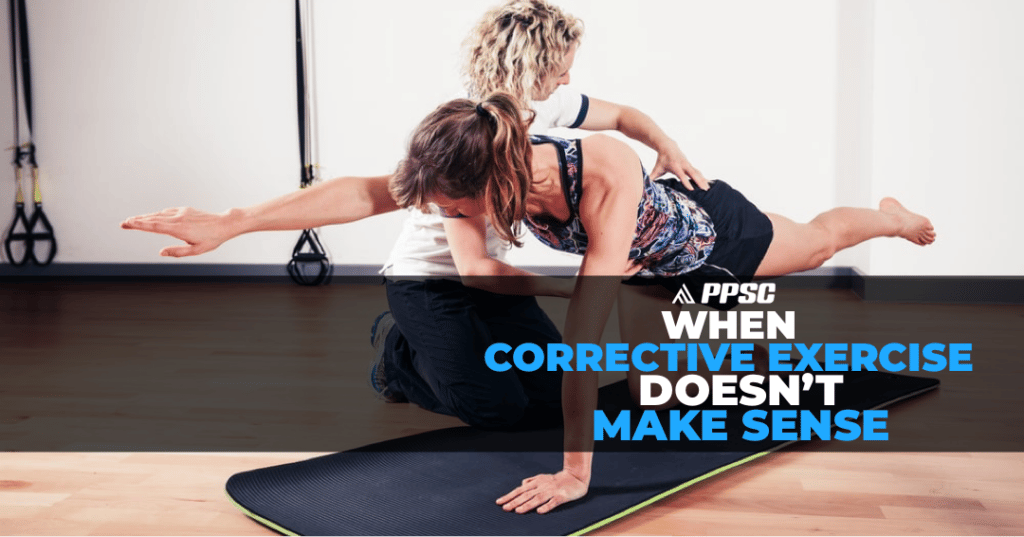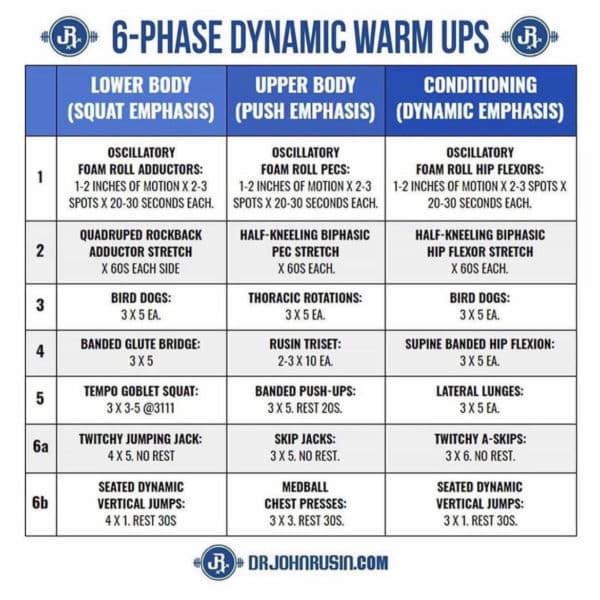A client comes in to work with you and they generally have a long list of goals: lose weight, build muscle mass, feel better, etc.
In the process of onboarding this person you start to find that their movement patterns don’t line up with what they need to do in order to be successful training. So, what do you do?
This is where we introduce Corrective Exercise.
One of the most beneficial and detrimental additions to a workout routine all the same time. You read that right, beneficial and detrimental ( we’ll get to that).
Our responsibility as coaches is to upgrade the existing physical (and mental) condition for the clients in front of us. Especially here at the PPSC, we believe in operating at a lifestyle that is as Pain-Free as possible.
Implementing corrective exercise is a very well-intentioned an appropriate measure for most of the clients that we come across. But like any protocol, there are always conditions and prerequisite that need to be met before implementing such protocol.
So this article is solely based on highlighting some of the glaring misses we met allow as coaches where corrective exercise just does not make sense.
What is Corrective Exercise

Corrective exercise is any exercise to facilitate a “more appropriate” movement competency throughout a specific path.
Movement competency through a specific pattern can directly relate to squat, an activity of daily living, or just something that you happen to come across every once in a while.
In any case, the coach feels it’s important enough to address and clean up this movement moving forward.
Without diving too deep into the weeds, it’s important to address there are a few things to consider before even thinking about implementing a corrective exercise:
Movement Screen – if you don’t have a consistent and replicable movement screen for your clients then there is no way to evaluate it. Our industry has hopefully progressed far enough that we are past the eyeball test. Find a screen or develop a screen that makes sense for the coaching of all of your clients. For PPSC coaches, you already have this covered.
Is it Essential – In training, unfortunately we tend to get caught up in the cool tricks while neglecting the important factors. Don’t start wasting time on something that’s a nice-to-have when you have a whole list of need-to-have’s.
As I mentioned earlier, corrective exercise is very well-intentioned. But being a qualified practitioner, it is your responsibility to decipher between what is critical to the goals at hand and what may not be the most important thing to address RIGHT NOW.
Because of the allure of corrective exercise, far too many coaches preach the magic of fixing somebody’s movement without checking the boxes of everything else that needs to happen prior to that.
So what are the boxes of when Corrective Exercise doesn’t make sense?
When You Aren’t Implementing a Warm Up Strategy
Click Image to download the 6 Phase Dynamic Warm Up Sequence Plan by Dr. John Rusin!
If you haven’t even embraced the process of a warm-up for your clients (or yourself) then you have no business working and corrective exercises from that lens. Going into the gym cold and trying to “correct” a movement pattern is just a silly concept.
When I say warm-up, I don’t mean 45 minutes of rolling around on a foam tube and mastering breathwork with a balloon. What I mean is a strategy to upregulate someone’s system to be prepared for the movement necessary in a workout routine.
One of the most common ways I see corrective exercises implemented in a very detrimental way, is when it doesn’t fit into the scheme of that person’s routine.
Client Scenario – Imagine a client comes into you looking to lose weight. They are about 45 pounds overweight and finally committed themselves to get on track and drop the extra pounds.
They have entrusted their process in your hands. That means their goals, their insecurities, their ambitions, their fears, and ultimately their soul.
With that much on the line, getting it right is critical. We may only have one shot with this person to get them committed to a healthy lifestyle.
This is when goals mean everything. What most coaches overlook is that a proper warm-up will in turn correct some of these glaring movement deficiencies. The way you move the first time you open your eyes in the morning is very different from the way you move midway through the day.
This new client to working out is just opening their eyes for the first time when it comes to Exercise, Health and Wellness.
Now is not the time to try and blow them away, see, now is the time to deliver. and if you aren’t implementing a warm-up to promote the most efficient movement possible in somebody’s exercise routine then you have no business trying to cherry pick corrective exercises to work magic.
When There Are Neighboring Contraindications

Not every scenario is perfect. I’m sure you’ve already lived life long enough to understand that.
The body is a highly complex relationship of muscles, tendons, bones, joints, and systems. So when it comes to choosing specific movements, we should consider all of these parts of the body.
Most people you come across in your training sessions have had some sort of injury in their life. A lot of clients can resume with a knee, shoulder, or lower back issue.
What is important to investigate as a coach is whether there are any contraindications to specific movements.
As I mentioned before, generally all coaches are well-intentioned. But working collaboratively with allied health professionals can help you better decipher which situations are worth approaching and which situations are worth avoiding.
If a client has previously worked with a physical therapist, doctor, or other professional who has advised them not to do a specific movement – adhere to that advice.
Coaching Tip – all of us have come across a client who got a training decision made for them by a Doctor, Physical Therapist, or other professional. Many times, I hear coaches upset about the verdict and unsure how the person came to that decision. My advice is to reach out to that Doctor or Physical Therapist and get more information. Don’t come in guns blazing, but with an open mind two professionals connecting over the care of this client’s well-being.
When It’s Uncorrectable

“You are all unique little snowflakes” is what PPSC Director, Clifton Harski, would say at a course to attendees. Obviously Not in a mean way but to drive home the point that we are all obviously very different people.
Sometimes we tend to forget that.
We look at the movement of another coach and wonder why I can’t move like that.
Well, you aren’t them.
It’s important to understand when movements are correctable and when they’re not correctable. The worst thing you can do is waste time on fixing something that isn’t actually possible.
There have been a number of times I see coaches trying to work on someone’s hip range of motion while noticing a glaring bony blockage, restricting the movement.
If the body can’t do something, it’s going to let you know.
This is where an appropriate moving screen may come into play and if you’re unsure ask for a second opinion from a trusted colleague.
Again, as mentioned before, ask yourself if this movement you are correcting is essential to the long-term plan for this client. if it is, refer them to a professional who can better assist. If it isn’t, who cares and move on.
For more info on 20 Different Squat Variations CLICK HERE
Which brings us to our next one…
When It’s Outside of Your Scope

In the last 10 years I’ve seen trainers try to own a lot of topics that are just completely outside of our scope of practice. I appreciate the ambition and willingness to want to help somebody but one of the most important factors of helping someone is knowing when you don’t know.
It’s absolutely okay to refer to someone who has a deeper knowledge within a specific area.
Build a network of trusty professionals in your neighboring area where you can refer clients. Professionals who believe in the importance of training and fitness towards a long life.
Once you build that network of people, you will always have a reliable space to send clients and may pick up some clients from those professionals as well.
Soft tissue manipulation, manual therapy, realigning joints – not something trainer’s can do.
When it Stops Correcting

There is a point in corrective exercise when you need to decide if it’s continuing to make positive changes or just continuing to happen.
When it stops “correcting” you should find a new plan or re-evaluate the existing one.
The brutal truth of the topic really comes down to this: did you as the coach choose the appropriate exercise in the first place and are they doing the exercise correctly?
“Wait, did you just challenge my skills as a coach”
I sure as hell did!
An overly ambitious exercise or poor execution are the foundation of corrective exercise purgatory.
If an exercise isn’t making the changes you want it to make after a certain period of time then you need to adjust the protocol. If you are unsure of how much change should be made – you shouldn’t be doing it in the first place.
Don’t allow corrective exercises to become habits of movement. They should be implemented as needed, for as long as needed, until no longer needed.
So, You Think Corrective Exercise Sucks?

Actually, I think corrective exercise is an amazing addition to someone’s existing programming. I also believe that more exercises than we imagined or actually corrected in nature. For example, squatting with heavy weight is a great way to help increase hip mobility to a certain degree.
What I do think is important is we are strategic about the things we implement.
If you weren’t checking the boxes to ensure efficient movement then you shouldn’t be aimlessly integrating corrective exercise without a plan in place. It starts with having a proper warm up sequence, avoiding contraindications, and understanding when it’s outside of scope.
Additionally, having the eye to distinguish when something is uncorrectable or stops working as an intervention.
As long as you are prioritizing exercise, I’m on board.
Just be careful with how you implement “corrective” exercises as the perception of your client and whether they enjoy them or not may be directly related to your practice of the topic.





